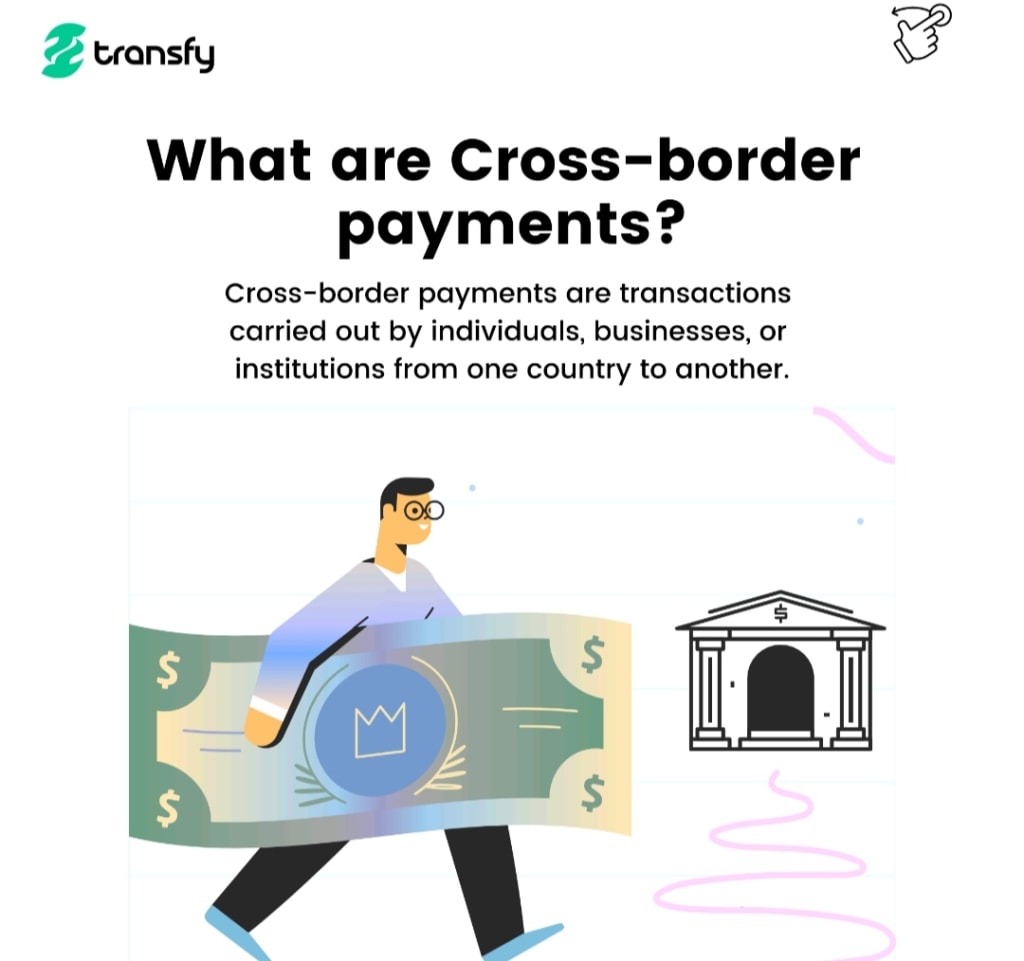What Are Cross Border Payments
Cross-border payments are rapidly growing with economic integration; not just in the financial sector but also in trade areas. And with economic globalization, many people are looking for easier ways to send and receive money from different countries/ continents.

With over 3 billion people actively using the Internet daily, an estimated 1.7 billion individuals are active on e-commerce platforms. Hence, the unending need for cross-border transactions.
However, cross-border payments are laced with challenges like high cost, slow transactions, and lack of transparency by the key players, to mention but a few.
In this article, we will discuss everything you need to know about cross-border payments, and how to overcome the challenges of cross-border payments with Transfy.
Transfy is a Pan-African fintech platform that provides an alternative payment method for cross-border payments and money remittances. You can easily send, receive money and make cross-border payments to individuals and businesses across Africa and beyond on the Transfy Platform.
What Are Cross-Border Payments?
You're making cross-border payments all the time. Most of the time, you don't even realize it's happening. For example, when you purchase a product on Amazon, AliExpress, or any other foreign eCommerce platform or paid for medical or travel expenses when out of the country.
Other times, cross-border payments can be as simple as sending money to a family member abroad, or a worker sending money home to support the family. If you've engaged in any of these activities, you're not new to the cross-border payments system.
So, what's cross-border payment all about?
Cross-border payments (also known as international payments) are transactions carried out by individuals, businesses, or institutions from one country to another. This can be done through several methods such as money transfers, electronic bill payments, bank drafts, etc.
Also, it's worth noting that cross-border payments can sometimes be expensive and also involve multiple intermediaries in the payment chain, such as banks, exchange rate providers, and payment processors.
Therefore, it's important you choose a globally-reliable cross-border payments platform.
How Do Cross-Border Payments Work?
When you make a cross-border payment, you're essentially requesting that your bank send money to a foreign bank on your behalf. This process involves the following three steps:
- Pre-funding
- Clearing
- Settlement
In the pre-funding step, the sender (a company or individual) opens and funds their local bank account.
Next, in the clearing phase, the funds are routed through a clearing bank (also referred to as a correspondent bank) in another country where the recipient is based.
Finally, in the settlement, the receiving bank credits the recipient's account with the funds.
Similarly, a cross-border payment can involve one or more banks for each step of this process – depending on how much money is being sent and which banks are involved.
Four Major Components of a Cross-Border Payment
Whether you're initiating or accepting a cross-border payment, there are four essential components you should pay keen attention to.
They include:
Currency: The currency a buyer wants to use to pay for a product or service e.g US dollars, Naira, Euro, etc.
Exchange rate: The amount charged by a bank for converting one currency into another during a foreign exchange transaction.
Payment type: The most common payment types are wire transfer and credit card, but when it comes to international payments, other options such as Automated Clearing House (ACH) and direct debit play an important role too.
Payee details: The person, company, or institution you're sending the money to.
Challenges of Cross-Border Payments
Individuals and businesses have faced a series of challenges in the process of moving money across the border. These challenges include:
- High Cost of Transaction
- Low speed
- Limited access
- Lack of complete transparency.
High Cost of Transactions
According to a World Bank report, the cost of sending money across two African countries is significantly higher than the cost of sending money to the Diaspora.
The African continent alone has amassed trillions of profits of up to $25.4 trillion in 2021, and are expected to reach $26.6 trillion worldwide by 2022, from cross-border payments. This is as a result of high transaction charges from traditional banks and Money Transfer Organisations.
The traditional banks and MTOs charge as high as 5-9% for every cross-border payment. This is because of the intermediaries involved, regulatory fees, and FX charges when converting between currencies.
Low Transaction Speed
Asides from the high cost of cross-border payments, users also have to deal with low transaction speed. Some cross-border transactions can take up to 3-5 working days or even more to process. This is as a result of the number of intermediaries, and several protocols and paperwork involved in moving money across the border.
For example, when transferring money from Nigeria to China through traditional banks, the money will have to move through intermediaries in the United States before it can be converted to the Chinese Yuan.
Limited access
Most of the key players of cross-border payments (traditional banks and MTOs) in Africa have few options for inter-African payments. They are mainly focused on moving money to countries and continents outside Africa like the UK, US, Europe, etc, with limited access to users who want to move money across Africa.
Thankfully, you can now use fintech platforms like Transfy to instantly and easily move your money across African countries like Zambia, Kenya, Uganda, Botswana, Nigeria, Ghan, Cameroun, South Africa, etc.
Lack of Transparency
The lack of transparency that exists in the cross-border payment system has proved to be a recurring problem for individuals and businesses who rely on cross-border payments. For instance, some traditional banks and MTOs do not relate the cost of some procedures and their hidden cost to users.
One may end up paying for more hidden charges than the actual cost of processing the transfers. Also, users should be able to track their money from time to time, but this option is not usually available with traditional banks and some MTOs.
Tips For Choosing a Cross-border Payments Platform
There are some factors to consider when choosing a cross-border payments platform. We've identified six key areas to help you choose the right platform.
Transparency
A great platform will be transparent about its pricing, making it easy for you to predict how much your transactions will cost. Such platforms should offer clear information on their deposit and withdrawal process – the terms and conditions surrounding these processes can vary quite a bit between platforms.
Speed
Some platforms provide same-day or next-day settlement with others taking longer, some can take up to five days depending on the country and currency pair. Thankfully, with Transfy, you get to enjoy fast transactions for your deposits and withdrawals at an almost instant speed.
Security
Every payment platform offers different levels of security against fraud and theft which can be an important consideration for high-risk industries such as e-commerce, travel, or hospitality. Transfy offers bank-level encryption that keeps your funds and details safe and secure against breach or fraud.
Integration
Most payment platforms offer integration with a seller's website via a widget or API. This allows businesses to accept card payments directly on their website with minimal setup effort by the merchant (although some platforms may require specific technical knowledge).
Customer support
A good cross-border payments provider will offer 24/7 customer support channels such as phone, live chat, and email in multiple languages including your local language if applicable.
Multi-currency support
Inquire about supported currencies and payment methods. Does the provider support credit cards or just debit cards? What about wire transfers? It's also good to find out whether there are any restrictions on what payment methods can be used on the platform.
How Can Transfy Help You with Cross-border Payments?
Transfy provides a seamless and secure platform that checks all the boxes you need to make instant payments without having to border about the high cost of transactions or slow transaction speed.
Moreso, the Transfy Multicurrency wallet makes it even easier to send, receive and exchange money between different African currencies without the stress of foreign exchange. You can easily exchange your local African currencies to GHC, ZAR, NGN, Kwacha, Pula, UGX, and KES, etc.
That said, the following steps will help you send and receive money on the Transfy Platform without hassles.
How To Use Transfy For Cross-border Payments
1. Create an Account
Visit www.transfy.io to register with your details and create an account on the platform. Upload the required KYC documents to get verified on the Transfy platform. This is crucial and it helps to clamp down on fraud and impersonation when moving your funds.
2. Fund Your Wallet
Fund your account securely through bank transfer or using a mobile money transfer. You can also fund your wallet with Mpesa, Airtel Money, Orange Money, MTN Momo, etc.
3. Send and Receive Money in Minutes
Provide the details of the recipient in the spaces provided. Select the payment channel - mobile wallet or local bank account, choose your preferred currency, then Click on SEND.
Transfy’s multicurrency wallet allows you to instantly convert your currency to any of the supported currencies. Your recipient can as well withdraw the money equivalent through their local bank accounts or mobile money agents.
About the Creator
Lisa Transfy
Transfy is a Fintech startup on a mission to connect individuals and businesses across Africa financially. This is by building a financial infrastructure which enables them to seamlessly and securely send money within Africa
Enjoyed the story? Support the Creator.
Subscribe for free to receive all their stories in your feed. You could also pledge your support or give them a one-off tip, letting them know you appreciate their work.






Comments
There are no comments for this story
Be the first to respond and start the conversation.